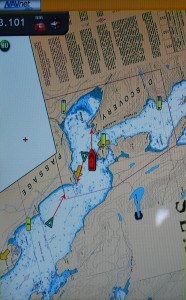After a quick 10-day trip home to take care of family and other business, we returned to April Point Marina on July 4th via Kenmore Air and are now aboard Flying Colours. After a day of provisioning and getting settled in, we departed early the next morning and are now at one of our favorite spots – Blind Channel Resort. We’ll be here for two days (maybe three if a storm out in Johnstone Strait doesn’t die down), then continue on to the Broughton Archipelago at the north end of Vancouver Island.
(Remember, you can click on any image to see an enlargement of it. You can also view the blog post in a better format by logging online and reading it there.)
But let’s back up and see what led up to this.
After Cortes Bay, we settled on a nice marina called April Point to moor Flying Colours while we flew home on Kenmore Air. It’s located on the west side of Quadra Island, on the east side of Discovery Channel from Campbell River. Tucked into a little bay, it’s pretty well protected from the weather, and with a free boat shuttle service over to Painter’s Lodge – their associated fishing camp lodge – it’s relatively handy for getting to the stores for provisioning and supplies in Campbell River.
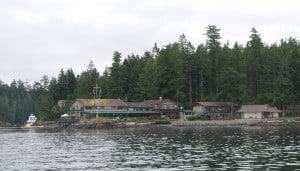
April Point Resort as we entered the bay. The April Point Marina is tucked into a small bay around the corner from the white cruising boat moored at a private dock on the left. The resort caters to people who just want to get away, with kayaks for rent, Vespa-type scooters to explore Quadra Island, and a spa for those who just want to get their nails and a facial done.
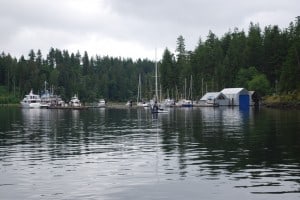
The April Point Marina looked almost deserted as we approached it – the last time we were here it was almost full of boats, but not this year.
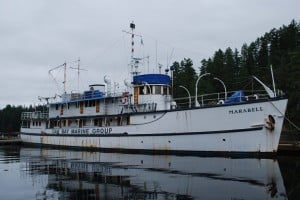
We were moored at an inside dock, just across from the Marabell. The Marabell has been moored here since our first visit two years ago, owned by the Oak Bay Marine Group – who also own the April Point Resort and Marina, Painter’s Lodge across Discovery Channel, as well as about five other marinas up and down the Vancouver Island Coast, plus two or three large sport fishing boats. She's about 100' in length, and probably started life as some type of coastal ferry. Most recently, the Marabell has been in the sport fishing trade, serving as a floating lodge for a couple dozen fishermen, who were launched in small fishing boats by day, and brought back to the Marabell for meals and accommodation. She’s starting to look like a rusty old heap, but she’s probably still in pretty good condition – and is for sale to anyone who might want to set up a guest fishing lodge.
In the last weeks before the trip home, we’d been getting word that Raz wasn’t doing well at “the spa” – the kennel near Sea-Tac where we left Raz and ZuZu together in a “suite” – their own private room that’s about 4’x8’ and sports a small human-style bed for Raz to sleep on, a cat tree for ZuZu, a TV on the wall to watch Disney animal movies in the evening, and windows to look out. She was depressed, shaking like a leaf, and chewing everything in sight. We had her taken to the vet for examination, but nothing physically wrong was found, and she was prescribed a very low dose of Alprazalam, a drug used to calm anxiety disorders. This bothered us a lot, as it’s very unlike Raz, and we felt there were other causes.
Because of the situation with Raz, a change in decision was made for the next month’s cruising – we’ll take both Raz and Gator to stay with Kelly Brammer for July, who runs an in-home boarding facility down in Bonney Lake (near Enumclaw) – we call it Camp Kelly. We’ll bring ZuZu back with us on the boat.
This change necessitates a considerable amount of cat glimp that we need to get in Campbell River – a litter box, litter, storage bins for food, cat food, and of course, toys to keep ZuZu occupied. We’d have to get across to Campbell River to get all that stuff, as it couldn’t fit with our luggage constraints on Kenmore Air.
We had an extra day to kill at April Point, so Kap and I rented Vespa-type scooters for three hours at the resort and toured the island. Not having transportation is one of the downsides to cruising, particularly when so many places that we visit are very hilly and not conducive to bike riding. The scooter also allowed us to stop at the Quadra Island grocery store about 4 miles from the marina, and we packed home a good portion of the non-perishable provisions we’d need for the next month’s cruising.
We also took the resort’s fast shuttle boat across Discovery Channel to Painter’s Lodge at the north end of Campbell River. Painter’s is a popular fishing lodge, and they cater to hundreds of fishermen who fly in for the salmon runs.
From Painter’s Lodge, we took a taxi into Campbell River and searched out every pet store in town for the stuff we’d need for ZuZu. Between the four pet stores, we were successful in getting almost everything we needed.
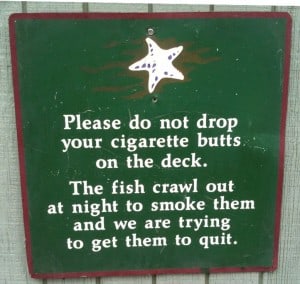
We spotted this great sign at the head of the dock at April Point marina. It’s always nice to see a sense of humor.
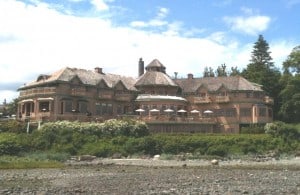
Painter’s Lodge is a pretty fancy-schmancy fishing lodge on the Campbell River side of Discovery Channel (on Vancouver Island). The main lodge building has a large restaurant, bar, and lobby area. Behind the lodge are at least 6-8 additional lodge units, containing dozens more accommodations.
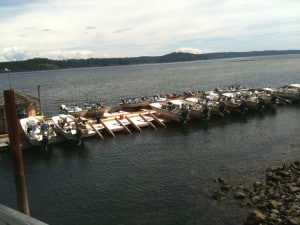
Both sides of the dock ramp have on-the-dock slips for the small fishing boats. Note that the fishing boats are up on the dock and out of the water. When a boat returns from a fishing trip, they first unload the fishing clients onto the dock from the bow, then the guide lines the bow of the boat up between two board ramps that are on center pivots, then guns the outboard engine and drives the boat right up onto the dock. As the boat rides over center, the ramps lay down flat on the dock, supporting the boat without the keel touching the dock.
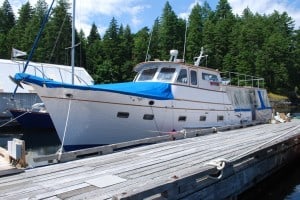
Compare these two photos to see the origins of Flying Colours. The boat on the left is a 1972 Defever Alaskan trawler, serial number 2, built in Hong Kong.
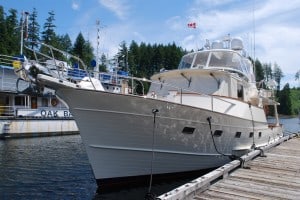
Here’s Flying Colours at the dock at April Point Marina, taken from about the same angle as the Alaskan trawler. The design similarities are striking.
On the next dock from us was an interesting boat – which we thought at first might be a very early Fleming (i.e., like Flying Colours). A couple live aboard her at April Point Marina, and when I stopped by to admire her lines, the couple came out to chat for quite a while. The husband is a retired shipwright (i.e., marine wood carpenter), and his retirement project is to rebuild this classic wooden boat to like-new condition – and he has a long way to go. We got to know him quite well, as he’s also the part-time dock caretaker who looks after people’s boats when they moor them here for long periods and return home.
His Alaskan was designed by a well-known Naval Architect named Arthur Defever, credited with originating the fishing trawler-look for cruising boats, and leading to hundreds of knock-off designs. Anyway, the story we heard was that when Defever designed the Alaskan, he approached Grand Banks Yachts – who were building the famous Grand Banks trawlers in Hong Kong – about buying his design. Grand Banks demurred, and so Defever decided to build it himself, calling it the Alaskan. The boat we were looking at was serial #2.
Shortly after that, Grand Banks decided to do a similar boat, and their designer was Tony Fleming. They subsequently dropped the idea for whatever reason, and Tony Fleming quit and went off to Taiwan to develop his own brand of boat – and that’s when the Fleming 55 was born (this was in 1985).
Copying (or adapting) a proven boat design isn’t considered plagiarism in this business, and what Tony did was to improve considerably on the Defever Alaskan design, with the result that the Fleming 55 – such as Flying Colours – is now considered the benchmark that all other trawlers are measured against. (It’s pretty amazing just how much of a traffic stopper Flying Colours is, and hardly a day goes by that other boaters on the docks come to see her, telling us that owning a Fleming is their dream. )
Kenmore Air flies right into April Point Marina, and we boarded the turboprop Otter right from the dock where Flying Colours was moored. There was only one other passenger on board – don’t know where he was picked up – and our pilot said we had two more stops before heading south to the Kenmore Air base at the north end of Lake Washington.
With me in the co-pilot seat and Kap behind – and Gator getting his own seat next to Kap – we climbed out and headed east to Read Island, landing on Calm Channel to pick up our next passenger at a private residence dock. It’s apparently a summer home for a Seattle couple, and she was heading down for a Nordstrom’s weekend (ooooh, that wasn’t very nice). We took off again, heading north on Calm Channel, and landing in Big Bay to pick up a guy – again at his private dock. Then we took off again and headed south, bypassing the normal Customs stop in Nanaimo, as everyone on board had a U.S. passport, and we were non-stop for Lake Washington.
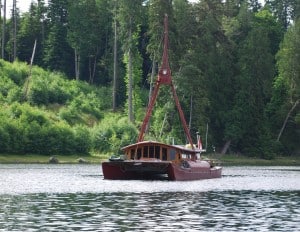
Here’s what everyone needs for their next Inside Passage vacation – a catamaran float home that somehow conjures up the image of a bag lady pushing a shopping cart. This gem came in one night just before sunset and anchored in a mud bottom area about 100 yards from our moorage in April Point Marina. It’s apparently available for charter, and it might be quite comfortable, but I’m not sure how it would handle in rough seas.
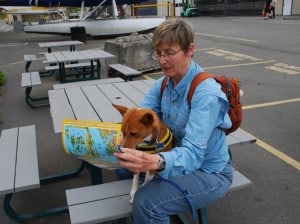
While waiting for the Kenmore Air float plane to take us home, Gator checked out the airline's route map to see where we were going.
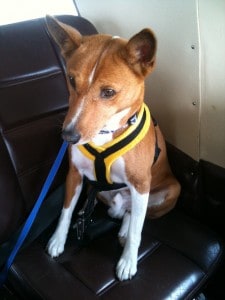
Gator was a really good sport on the flight home. There were only three passengers plus the pilot, with a total of 8 seats, so Gator got his own seat next to Kap. Kap tried foam ear plugs on Gator but he wasn’t thrilled about them. Luckily, the Turbo Otter isn’t nearly as noisy as the piston Beaver floatplane that we were expecting.
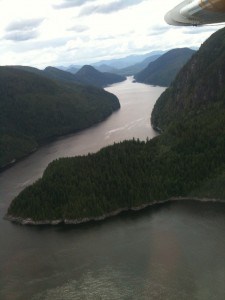
Along the flight route southwardfrom Big Bay, we passed Hole In The Wall Channel. We explored this narrow channel separating Maurelle Island from Sonora Island on our first cruise north in 2007. We were going “up the back way” to the Broughton’s that summer, and needed to wait for slack at Yuculta Rapids.
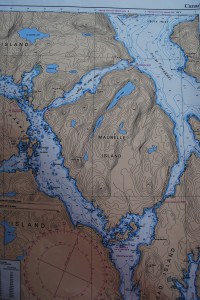
Here’s what Hole In The Wall looks like on the nautical chart – it’s the meandering blue sliver in the upper third of the chart, separating Maurelle Island to the south from Sonora Island to the north.
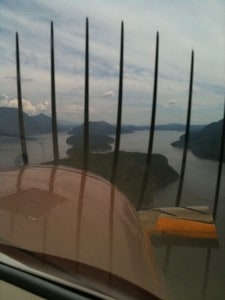
This is a pretty cool shot – totally unexpected, and from my iPhone camera. I aimed the lens through the front windshield of the Turbo Otter, figuring that the prop speed was no match for the shutter speed of my iPhone camera – and amazingly, it “stopped” the prop, most likely on several rotations.
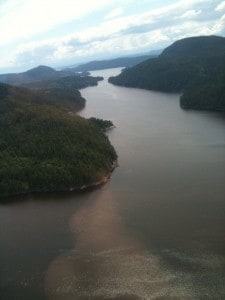
In the distance is Dodd Narrows, just south of Nanaimo. This narrow slit of water is the faster way to get in or out of Nanaimo, eliminating a long passage around Gabriola Island. As it name implies, it’s narrow, forcing the flooding or ebbing tide to “rush” through it, creating havoc with boats passing through it at any other time than “slack” water – which is defined as the few minutes when the tidal current is switching from flood to ebb (or vice versus). Slack only occurs twice a day, so cruisers have to time their arrival at the narrows for the slack that suits their travel plans.
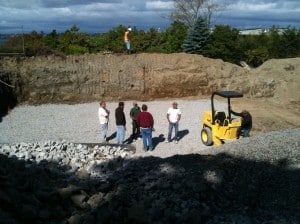
Here’s part of the reason we went home – to check on construction progress of our new house. This photo was taken on June 29th, and foundation excavation is almost complete. They’ve laid a shallow fill of 3-4” crushed gravel because the dirt beneath it turns to muck if there’s any rain between now and the time they get the foundations poured and the subflooring laid in.
July 4th and it was time to return to Flying Colours. This time, though, we were relegated to a wonderful and trusty old deHavilland piston-driven Beaver, which is a real pilot’s airplane . . . but probably a bit noisy for ZuZu. She wasn’t happy at all being crammed into her small traveling Sherpa bag, and meowed even more than normal. Check-in at Kenmore Air was expecting us with extra baggage, plus ZuZu, and we were directed to “Table #1” – Kenmore Air’s version of a departure lounge is a collection of picnic tables between two docks lined with float planes. Our only other passenger on the trip north was a guy flying up to his fishing lodge on the west coast of Vancouver Island, so that’s the reason for the 6-place Beaver instead of an 8-passenger Otter.
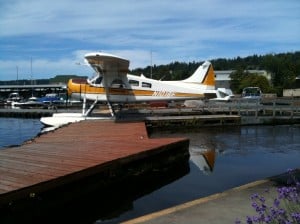
This piston-driven deHavilland Beaver is our trusty steed for our return to April Point on July 4th. Just below the airplane’s nose you’ll see a dog standing there. She’s an Australian cattle dog, actually a Blue Healer, named appropriately, Blue.
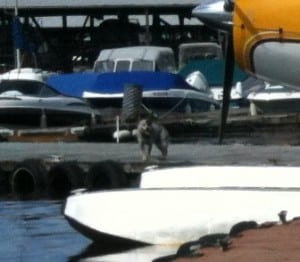
Blue definitely runs the ramp operations for Kenmore Air flights departing from the North Lake Washington base. Blue runs around like crazy, showing passengers where their plane is, runs in tight circles on the dock as the plane is moving away, and grabs the tiedown ropes in her teeth. She has enough energy to make anyone want to take a nap after watching her for just a few minutes.
Again, for weight and balance reasons, I had the co-pilot’s right seat up front, while Kap sat behind with ZuZu – who had to remain in her Sherpa bag for obvious reasons. Even with ear plugs in, the noise from the piston-driven 9-cylinder radial engine is jarring – and I can’t imagine what it must be for a cat, who isn’t going to stand for ear plugs no matter how much they benefit her. I’m sure she dug out the pad in the bottom of her Sherpa bag, crawled under it and curled up as tight as she could to endure the two-hour flight to Nanaimo and Customs clearance.
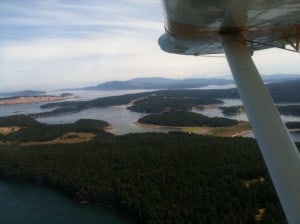
I snapped this photo with my iPhone camera as we passed Roche Harbor on San Juan Island. Being July 4th, the place is swamped with boats for the fireworks late that night. Right in the center of the photo, and hidden by the hillside of trees is Henry Island, home of the Seattle Yacht Club outstation, one of the most popular in the string of 11 outstations owned by the club. For the 4th, they always have a huge family day, with upwards of 60 SYC member boats crammed onto the docks, and over 150 people for the weekend of BBQs and family sports activities. For two cruisers without kids (us), it’s a huge reason not to be there.
In Nanaimo, we landed at the Kenmore Air dock, where two Canadian Customs people were waiting to look over our paperwork and decide if they wanted to let us into Canada. We deplaned, presented our passports, and the only additional thing they wanted to see was ZuZu’s rabies certificate. After producing that, we got back on the Beaver and took off again, this time for the hour-long flight to April Point. We arrived at 2PM, again on the same dock where Flying Colours was moored.
After our return to April Point, Kap constantly listened to the VHF weather reports from Environment Canada for wind and waves conditions in Johnstone Strait, plus she has a nifty program on her iTouch (and her laptop PC) called Predict Wind that gives very accurate localized wind forecasts. The decision on when to leave was touch and go several times, and Kap agonized. In the meantime, I rented one of the resort’s Vespa scooters and made two trips to the grocery store, hauling two bags of groceries on each trip.
That night for dinner, we splurged with our first Flying Colours special Shrimp Scampi dinner with prawns caught at Cortes Island. They were excellent! Hard as it is to grit our teeth and kill these guys, we pay homage to them when they taste so good.
July 5th was reserved for final provisioning. Our original plan was to put the dinghy in the water and scoot across to Discovery Marina in Campbell River. That would have put us very near to the shopping areas we need to visit – but the weather forecast was for high winds on Discovery Channel, and along with strong current, it just didn’t seem prudent to be out there in our dinghy. Instead, we took up the young marina manager’s offer to drive us to the BC ferry terminal a few miles south for the car ferry from Quadra Island across to Campbell River.
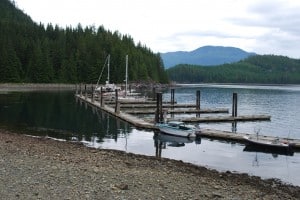
Upon our return to April Point, the docks had filled in quite a bit with new boats. Here’s Flying Colours tucked in on an outside dock.
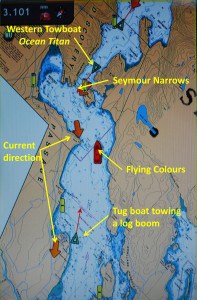
Here’s what Seymour Narrows looked like on our Furuno Navnet 3D chart plotter screen as we approached Seymour Narrows. Slack was at 9:46AM, and at our current position, we’re about ten minutes ahead of that (the tidal current arrows show that we’re still facing a current against us, and it should turn to slack at 9:46). Approaching Seymour Narrows from the north is the Western Towboat, Ocean Titan. Behind us is a tug towing a log boom, but he’s going a couple knots slower than us, so he’s not a factor. Seymour Narrows is about ¼ mile wide, which seems like a lot . . . until you find yourself with several boats alongside, plus meeting other boats and tugs towing large things.
On my trip to SE Alaska in 2003 aboard the Western Towboat, Pacific Titan towing a barge, going through Seymour Narrows on our second night out was my first-ever encounter with a “narrows”. I had no idea what to expect, and was totally clueless of what it would be like. As we were passing Campbell River on that trip, I vividly recall the captain, Doug Myers, calling the owner of Western Towboat at home from his cell phone, as we were a bit late for going through Seymour Narrows from the time of slack. I was in the tugboat’s pilot house (at least 40’ off the water) at the time, and Captain Myers told the owner about the situation, that it was an ebb current (i.e., flowing north, the direction we were going, so he’d have a following sea), and he said, “the current is at x knots (I don’t remember the number), and I’m not going through unless you give me a direct order to do so” – obviously a CYA situation, where if anything went wrong the onus would be on the shoulder of the owner. They talked it over for a few minutes, and he apparently got the order, as the decision was made for us to go through.
In the minutes before we got to Seymour Narrows, Captain Myers reeled in the tow line to where the barge was maybe 125’ behind us – to give him more steering control over the barge as we made the turn into the narrows.
I had never before seen whirlpools like we went through – they looked like swirling funnel openings in the water. The bow of the tug slewed from side to side like it was a matchstick – and this is a tugboat that weighs almost 200,000 lbs! What I remember the most, though, is looking out aft pilot house window and seeing the tugboat’s stern underwater – yes, and a good foot of water washing over the aft deck – as the incredible water vortexes tried to pull us under. I looked at Captain Doug, and while he was grim-faced, he was trying not to show any emotion, but I have a feeling he too was churning inside.
If the water in a narrows can do that to a 200,000 lbs boat, you can imagine what it can do to a 70,000 lbs boat like Flying Colours.

Here’s the Western Towboat (from Seattle), Ocean Titan, a 120’ tug – similar to the one Kap and I went to SE Alaska on in 2003 and 2006 – towing a 400’ barge partially full of containers (probably empty) and heading towards Seattle.
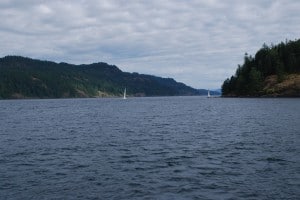
And finally, here’s what going through Seymour Narrows should look like – at slack current, no whirlpools, and almost boring looking. We entered it at 1 minute past the official time of slack.
Kap had been worried about the conditions on Johnstone Strait. The weather forecast was for freshening winds at about noon, and it’s not uncommon for the timing to be off. As we continued up Discovery Channel beyond Seymour Narrows, the big question was what it would be like as we rounded Chatham Point and into Johnstone Strait.
Johnstone Strait runs from SE to NW along the top 1/3rd of Vancouver Island, for a total length of about 68 miles. Mountain ranges near both shores force the onshore wind from the Pacific into the strait, causing the prevailing winds from the NW. Gale force winds – winds higher than 35 knots (about 41 MPH) – are fairly common, and they whip up what are called wind-generated waves that need to be treated with respect.
Today’s conditions couldn’t have been better. Seas were calm, the winds stayed around 10 knots (mostly on our nose), and even though it was wind against current, the waves weren’t more than 1-2’. Nevertheless, ZuZu tucked into her covered bed, with pillows shutting off both ends so she couldn’t see anything, and slept the entire 3-hour cruise to Blind Channel.
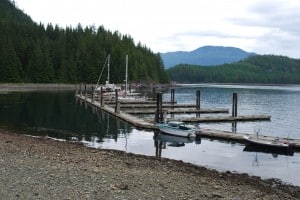
Here’s the Blind Channel docks when we arrived – empty except for one sailboat, plus Flying Colours.
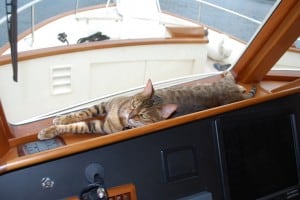
After her first day aboard Flying Colours while cruising this year, ZuZu needed a good rest to calm her nerves. One good place to do that is to squeeze into the nice warm wedge between the pilot house dashboard and the main windscreen.
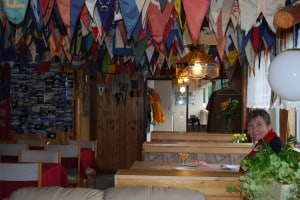
The weather forecast was better for Wednesday night than Thursday, so we booked a Wednesday night dinner reservation at Cordero Lodge. The dining room at the floating resort is tiny, with seating for fewer than 20, and we had the place all to ourselves. The triangular things hanging from the ceiling are hundreds of yacht club burgees collected over 30 years.
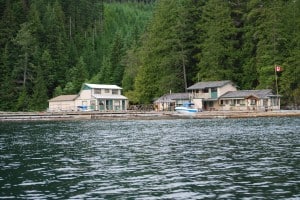
The view of Cordero Lodge as we head home after dinner. It was really sad to know this is our last summer to have a wonderful German schnitzel dinner here, and we really hope they’ll find a good buyer for it. Everything here is on floating docks, but they have shore access so guests can use the hiking trails.
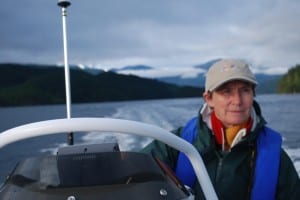
Kap driving us back home after dinner. The night was warm, but at 18 knots and on the water, it’s still cold enough that you really welcome a jacket.
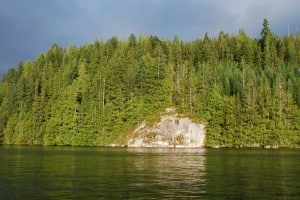
This shoreline along Erasmus Island(on Cordero Channel) illustrates the challenges of being at anchor when we have the dogs aboard – getting them to shore twice a day to do their “business” is really difficult when there’s simply no place to land the dinghy on a beach. Dense stands of Douglas Firs line the shore, with branches that hang 10-12’ over the water, and vertical rock faces rise directly from the water. Dogs who haven’t grown up aboard a boat often have a very difficult time accepting the idea of using a little patch of grass in a “pup head” on the boat’s deck – that’s definitely true for Raz and Gator – and they’ll hold it for days and wait until we get someplace where they can go ashore.
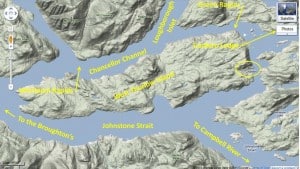
Blind Channel is on the eastern end of West Thurlow, and is about as remote as you can get out here in this wilderness. The only access is by boat, and the nearest town is Campbell River, 15 miles away, first down Johnstone Strait, then through Seymour Narrows, and into Discovery Passage.
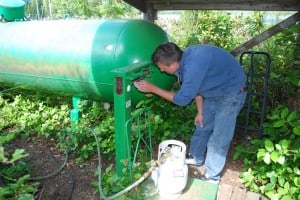
Scotty, the summer hand working the guest boat dock and fuel dock this year, is weighing our BBQ propane tank. Back home, they’d have a fuel gauge that measures exactly how much it’s filled with. Here’ he carefully weighs the tank before to find out how full it is, then fills it with the appropriate weight of propane indicated by the weight bar floating to the middle of the scale. Not very high tech, but it’s how you do it in the boonies.
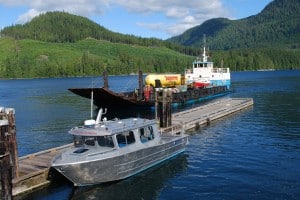
The gas/diesel/propane barge sidles up to the fuel dock to pump fuel into their underground tanks. Amazingly, this barge carries up to five “cruise” passengers on its rounds during the summer months – five day cruises that really give the guests an idea of what it’s like at these remote “resorts”.
It looks like we’ll spend three days at Blind Channel. The more we listen to the weather forecasts, the more it convinces us we want to stay put until the winds die down. On Thursday (July 7th), there were again gale force winds on Johnstone Strait, and in the afternoon we had a sustained gust at our dock that measured 30 knots on our anemometer. It’s usually pretty well protected from winds in Blind Channel, and this surprised everyone here.
Throughout the day, more and more boats arrived, reporting how nasty it was out on Johnstone Strait. It’s either bad timing, or impatient boaters who only have a couple or three weeks holiday to get where they’re going – but we’re always surprised at the number of boaters who are out in that kind of weather. I sometimes get frustrated at Kap for her cautiousness, but as a result of it we seem to have fewer bad days on the water – when we do, it’s usually due to circumstances beyond our control (like last year when we had to leave Gorge Harbour in gale force winds because their docks were full).
We spent most of the day fiddling around with Flying Colours’ tasks – refilling the propane tanks for the BBQ, doing laundry – and chatting with other boaters on the dock. We’ve also gotten to know some of the young staff at Blind Channel – really hardworking college-age kids who take summer jobs here and return every year. A young guy working the docks, Scotty, isn’t a college student right now, but told me he’s out getting some “life experiences” for a few years, and has promised his parents he’ll head for college by the time he’s 25. Another young guy and a gal are college students – he’s the noontime short order cook at a BBQ stand the resort set up on the patio outside the General Store; she works behind the counter in the General Store. All of them fill in during slow hours doing various yard and garden work around the resort, plus fill in bussing tables at night in the restaurant.
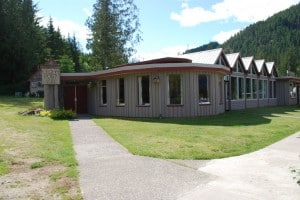
They call their restaurant the Cedar Post Inn. It was built back in the 60s or 70s by the original generation of Richters here at Blind Channel, and it’s run by their grandson and his wife. The food is excellent, with a couple of fresh seafood dishes from the local area, three German dishes (schnitzel, roulladen, and goulash – all excellent), appetizers (locally caught spot prawn cocktail), and salads and soups.
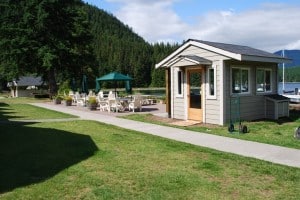
Along the shoreline bank there’s a new (since two years ago) patio and lunch BBQ area. We were here when 3rd generation Eliot Richter was laying the stonework for the patio – and as he chatted with us he commented that he’d just laid brick #900 something. At the time, the BBQ was done from a grill wheeled out each day, but since last summer they’ve now built a little BBQ kiosk to keep out of the hot sun, wind, and rain. The open-air structure at the far left was built last summer, with the construction timed just right for the wedding of Eliot’s wife’s (Laura) sister to get married in – and now it’s a Happy Hour gazebo. To construct this, all of the materials were either hauled in on the weekly barge, or brought out from Campbell River in their 16’ runabout.
We’ve also gotten to know the family that owns Blind Channel – four generations of the Richter family who live here – starting with the 85+ year old grandfather who created the resort at least 50 years ago. He’s retired now and we rarely see him, except for an occasional visit to the restaurant at night. In the next generation down, the 50-year old Richter son (sort of a dour guy) manages the General Store, while his wife does the daily baking of bread and cinnamon rolls for the store and restaurant. The third generation couple are late 20-somethings or early 30-somethings, are the new blood for the resort, having returned three years ago from good jobs in Vancouver, deciding this is a lifestyle they’d prefer to raise their family – a 2-year old and another on the way that represent the 4th generation.
The amazing thing about this operation is how remote it is, and therefore, what’s required to run an operation like this. It’s located on West Thurlow Island – about 10 miles long from west to east, and 4-5 miles wide – located across Johnstone Strait from Vancouver island. Outside of the Richter family at Blind Channel (which is maybe a total of seven people, plus another 4 summertime college students), the population of the island is virtually zilch, with no roads whatsoever on the island (other than logging trails), and the only access is by boat. They provision the General Store and restaurant entirely by weekly trips in a 16’ runabout, zipping across Johnstone Strait to a landing on Vancouver Island where they’ve stashed a car. From there they drive 15 miles south to Campbell River, returning with the boat filled to the gunnels with food and supplies. Once a week a fuel barge stops by to fill their gas and diesel storage tanks at the fuel dock, and then runs onto the shoreline with its landing craft front ramp to refill the propane tank on shore. Kenmore Air and B.C. Air floatplanes fly in every other day or so, neither with any supplies, but rather, guests arriving and departing on cruiser’s boats at the dock.
It’s definitely a lifestyle choice, and one that suits some people fairly well, and we’re glad there are people who will do this. We try to support them as much as we can, and they’re here to support us – what a mutually beneficial arrangement! It always amazes us to hear people complain about the prices for fuel, provisions, and meals that they have to charge in these areas – I guess they figure all this stuff grows on trees out back, or there’s a Wal*Mart just down the lane.
After tonight’s final dinner at Cordero Lodge, we’re hoping to head tomorrow morning for Loughborough Inlet (pronounced lock’-burro). The plan is to anchor in a small inlet, called Beaver Inlet, about three miles up Loughborough, and see what our success is with prawning there. The area is reputed to be very good for prawning, and if all goes well, we might land a good batch for our freezer. We’ll also be completely out of cell phone range, plus no Internet, so I won’t be posting anything further until we reach civilization again.

